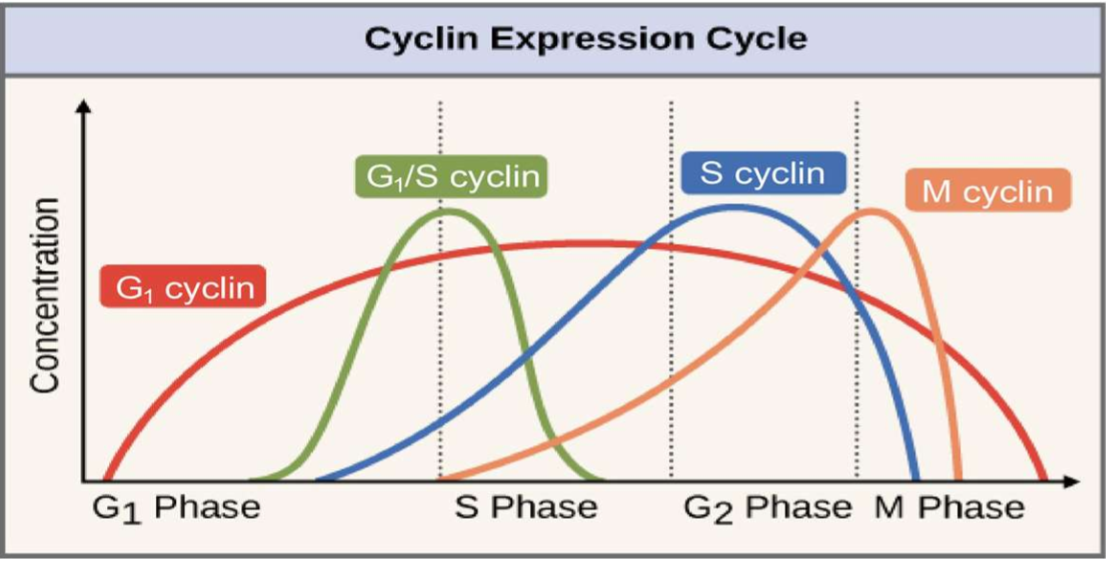Cell Cycle + Cell Cycle Regulation
1/39
Earn XP
Description and Tags
Name | Mastery | Learn | Test | Matching | Spaced |
|---|
No study sessions yet.
40 Terms
Why do unicellular organisms divide?
To reproduce
Why do multicellular organisms divide?
Growth and development
To replace damaged/dead cells
Binary fission
A method of cellular division that only requires replicating and splitting genetic material to create an identical daughter cell; used by prokaryotes
Interphase
The part of the cell cycle in which the cell grows, carries out normal functions, and replicates its DNA (consists of G1, S, and G2)
G1 phase
The cell goes through normal growth and processes
S phase
The cell duplicates its DNA
G2 phase
The cell prepares for nuclear division
M phase
Division of the nucleus (eukaryotic cells) and the rest of the cell
Mitosis - somatic cells
Meiosis - gametes
Chromatin
“Unwound” form of genetic material - consists of DNA/histone protein complex
Chromosomes
Densely wound and packed chromatin - each species has a different number of chromosomes per cell, represented by n
How many chromosomes do humans have?
n = 23; this means gametes (haploids - n) have 23 chromosomes and somatic cells (diploids - 2n) have 46
Homologous chromosomes
Chromosomes that encode for the same gene, but different alleles; one from mom, one from dad
Sister chromatids
Two copies of the same chromosome stuck together by a centromere
Kinetochore
The protein complex in a chromosome’s centromere where the spindle fiber attaches
G0 phase
A phase in which the cell is ‘arrested’ in interphase. May happen because
The cell has differentiated
There are not enough nutrients to go further with the cell cycle
Phases of Mitosis
Prophase
Chromosomes condense
Nuclear membrane dissolves
Spindle fibers begin to form
Metaphase
Chromosomes line up on the metaphase plate
Spindles attach to sister chromatids
Anaphase
Spindles pull sister chromatids toward opposite poles
Telophase
Chromosomes begin to unravel
The nuclear membrane begins to rebuild around the separated chromatin
Cytokinesis
The splitting of the cytoplasm between the daughter cells
In animal cells: the cell membrane pinches off at a place called the cleavage furrow
In plant cells: vesicles of cellulose form a cell plate and eventually a new cell wall in between the new cells
What is the Chi-Squared test used for?
To tell whether the difference in between two groups of data is statistically significant or not
How to tell how many degrees of freedom you should use in the Chi-Squared test
Use one less than the number of possible outcomes (ex. in the cell cycle lab, we used 3 df because there were four possible outcomes: interphase, prophase, metaphase, and ana/telophase)
Null hypothesis (H0)
A statistical assumption that states there is no statistically significant difference between the two data sets
Alternative hypothesis (HA)
A claim that states there is a statistically significant difference between the two data sets
Cell cycle checkpoints
Control points where ‘stop’ and ‘go ahead’ signals from inside and outside the cell can regulate the cell
G1 checkpoint
The cell checks for
Regular growth
Sufficient resources
Normal DNA
If all these are ‘yes,’ the cell enters S phase
If any of these are ‘no,’ the cell goes to G0
G2 checkpoint
The cell checks for
Correctly copied DNA
If this is ‘yes,’ the cell goes to mitosis
If this is ‘no,’ the cell goes through apoptosis
M checkpoint
During metaphase, the cell checks for
Chromosomes correctly lined up on the metaphase plate
If this is ‘yes,’ the cell goes to anaphase
If this is ‘no,’ the cell goes through apoptosis
Growth factors
Molecular signals released by certain cells that stimulate surrounding cells to divide
Cyclin-Dependent Kinase (CDK)
Enzymes that are always present in the cell; they help the cell proceed to the next step of the cell cycle (in checkpoints) when activated by a cyclin. Each different checkpoint had a different type of CDK and cyclin.
Cyclin
Proteins that activate CDKS in checkpoints to help the cell proceed to the next step of the cell cycle. Each different checkpoint had a different type of CDK and cyclin.

APC/C
A protein that facilitates the degradation of the centromere during the M checkpoint

Mutation
A change in DNA sequence resulting from exposure to chemicals/radiation/UV or incomplete repairs
Cancer
The uncontrolled proliferation of cells
Tumor
A cluster of cancerous cells
Metastasis
When cancerous tumors spread to other parts of the body
Proto-oncogenes
Genes that make the cycle go forward when necessary
Tumor suppressor genes
Genes that slow the cycle down when necessary
What happens when a proto-oncogene is mutated?
When a proto-oncogene mutates, it is called an oncogene. Oncogenes make the cycle move forward even when it’s not supposed to, like the accelerator of a car being much too strong.
What happens when a tumor suppressor gene is inactivated?
If a tumor suppressor gene is inactivated, it can no longer make the cycle slow down when it has to; this is like the brake petal of a car not working
Contact inhibition
When cell division is inhibited by contact with another cell, preventing an excess of cells
Density-dependent inhibition
When cells get too dense in a certain area, they stop dividing - cancer cells do not have this ability, which is why they form tumors.
p53
“Guardian of the genome:” tumor-suppressor gene that either stops the cell cycle or initiates apoptosis in cases of DNA damage